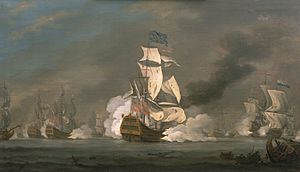Robert Woodcock facts for kids
Robert Woodcock (born October 9, 1690 – died April 10, 1728) was an English artist, musician, and composer from the Baroque period. He is famous for creating some of the earliest known concertos for the flute and the first known English concertos for the oboe.
About Robert Woodcock's Life
Robert Woodcock was born in Chelsea, London, and was baptized on October 9, 1690. His parents, Robert and Deborah Woodcock, ran a girls' school in their home, Shrewsbury House. His family was quite well-off, and his father was called a "gentleman," which meant they had a good social standing.
In 1714, Robert married Ayliffe Stoaks, and they had several children together. For a while, he worked for the government as a clerk. Around 1723, he decided to leave his government job to become a full-time artist. Sadly, he suffered from a painful illness called gout, which led to his death at the age of 38 on April 10, 1728. He was buried at Chelsea Old Church.
His Art and Music
Woodcock was a special kind of painter called a marine painter. This means he focused on painting ships and scenes at sea. He was greatly inspired by a Dutch painter named Willem van de Velde the Younger and often copied his style to learn from him.
Besides painting, Robert Woodcock was also a very talented musician and composer. He played the oboe, recorder, and flute. Many people thought he was especially good at the flute. In fact, nearly 50 years after he died, a writer named John Hawkins called him "a famous performer on the flute."
In 1725, an engraver named George Vertue described Woodcock as "An ingenious gentleman lover of the arts of painting and music." Vertue also said that Woodcock was very skilled in music and played the oboe "in a masterly manner." He mentioned that Woodcock had published some of his music, and other skilled musicians really liked it. Vertue's notes show that Woodcock was a respected musician and composer. He also described Woodcock as "a man of genteel mien," meaning he had a polite and pleasant appearance.
Woodcock's Concertos
Robert Woodcock's most famous musical works are a set of twelve concertos. A concerto is a piece of music where one or more solo instruments play with an orchestra. These concertos were published around 1727.
- Three of these concertos were for the flute.
- Three were for the recorder.
- And three were for the oboe.
The three flute concertos are the earliest known ones ever published for that instrument. And the three oboe concertos are the first known ones written by an English composer. Other famous composers like Vivaldi and Albinoni also wrote concertos for these instruments around the same time.
We know that some of Woodcock's concertos were played even before they were published. For example, in 1722, an advertisement announced that a "new concerto, compos'ed by Mr. Woodcock" would be performed. This shows his music was popular and performed often in England during his time.
For a while, some people wondered if Robert Woodcock really wrote these concertos, or if they were by other composers like Jean-Baptiste Loeillet of London or George Frideric Handel. However, more recent studies have confirmed that Robert Woodcock was indeed the true composer of these important works.


